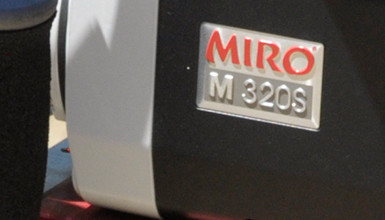We've been posting behind the scenes photos from each of the five selected Miro High-Speed Inspiration Challenge projects on the Phantom Miro Facebook page, but here are few more details on each of the projects and why they wanted to shoot with the Phantom Miro M320S.
Laura Egan -- Anchor Me Here

After spending time on the ground in areas affected by Hurricane Sandy, Laura Egan and her team decided to make a film that captured the response to the storm, especially the perseverance and resilience of individuals and communities, they witnessed. Laura says she "will showcase high-speed and real time footage side by side to create the feeling of a Hurricane that leaves sudden stillness in its wake."
With the Phantom Miro M320S, the team will be able to photograph non-actors -- children, homeowners, first responders and witnesses of the storm -- without the disruption and intimidation a larger camera could cause. "Nimble, discreet, and non-invasive, the Miro is the only tool for the job," says Laura.
Robert Kolodny -- Fly on Out

Robert Kolody chose to use the Miro M320S to tell a narrative story about a young boy who is being chased through the streets of Brooklyn while trying to set a bird free. "The film's goal is to portray the boy's struggle and sense of urgency within a fully realized and highly impressionistic interpretation of Brooklyn," says Robert. He intends to use high-speed to heighten the emotion of the story and capture the details of the borough in a "hyper-realistic" fashion.
The compact form factor of the camera was also attractive, since the production needed to shoot in tight spaces and be highly mobile.
Peter Nelson -- The Dance of the Honey Bee

Director of Photography Peter Nelson is also a beekeeper. His short, Dance of the Honey Bee, will blend art, science, nature and dance as it explores life within a beehive. Peter will take advantage of the small size and high ISO of the Miro M320S, as well as high-speed and macro photography to reveal the secret life of the of bees. He hopes to capture the "intricate and delicate beauty of their communications," as well as never before seen images, such as the exact moment of bee sting in slow motion.
Peter says that because of the technical features of the Miro camera and the beauty of the full HD slow motion, he could not think of another camera that would let him capture the images he wants in the field.
Nathan Pardee -- The Great Sundering

The Great Sundering is the story of a young boy who builds a giant Lego city only to gleefully destroy it in a monster costume. Director / Cinematographer Nathan Pardee takes advantage of the Miro M320S's form factor to get up close and personal with the Lego citizens and capture unique shots from their point of view using Macro lenses. The size and weight of the camera also allows him to simulate aerial shooting using a lightweight Steadicam and portable slider.
Pardee explains how high-speed imagery comes into play: "The destruction of a Lego city is something that happens in mere seconds. When slowed down using the camera's ultra high-speed capability, the colorful blocks flying through the air will be a dramatic, vibrant spectacle."
Tim Wu -- A Closer Look

In his Miro Challenge submission, Tim Wu described his project like this: "Illium Pictures will use the new Phantom Miro to take a closer look at one of the world's most universal languages: music. Not only to experience the beauty of instruments and sound on a visual scale unlike ever before, but to see what effect music has on the human brain on a microscopic level: and all at the incredible frame rates that have made the Phantom name synonymous with high-speed."
The film will showcase unique perspectives on musical instruments, actors in an intimate setting, and microscopic reactions within the human body. The Miro M320s is unique in its ability to capture all these moments with one camera.
We are looking forward to seeing all five of these very diverse films in their finished form, and we'll be posting much more about them throughout February. Keep an eye on this site and our social media channels for updates.
Remember the Grand Prize Winner will receive a Phantom Miro M320S package courtesy of Vision Research. It's going to be an exciting month leading up to the big announcement at the beginning of March.













